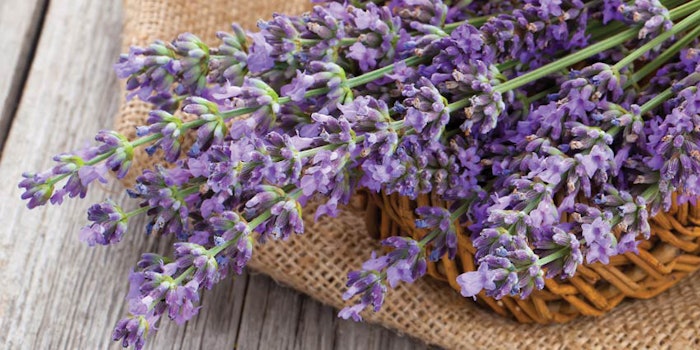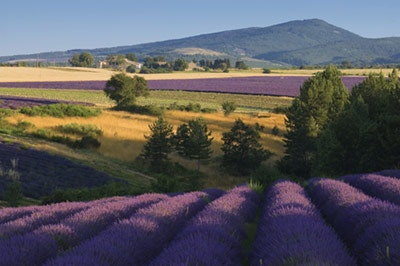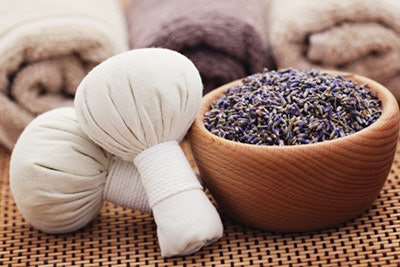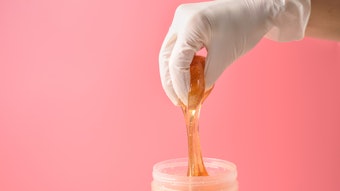
In a world of multi-tasking, social media, stress and burnout, lavender comes to the rescue. The bluish purple flower gives abundantly of itself and asks so little. For the 21st century, lavender is our friend and ally, a much needed botanical. Wear it, inhale it and bathe in it. Step into an increased sense of well-being, happiness and peacefulness. Let’s rediscover lavender.
History
The use of lavender dates back over 2,500 years ago when ancient Egyptians were known to use it for perfume and mummification. The Greeks and Romans bathed in it, and Romans found many medicinal uses. Hippocrates, the “father of medicine,” whose Hippocratic Oath is still acknowledged and repeated by doctors today, utilized lavender as an aromatic oil to heal body, mind and spirit. Lavender was popular with both Queen Elizabeth I and Queen Victoria of England, who both enjoyed its aromatic powers. Queen Elizabeth I was known to drink lavender in her tea for migraines, and it has also been added to teas for respiratory improvement. Queen Victoria loved it so much that England saw the first commercial production of lavender.
In 1910, famous French chemist and scholar René-Maurice Gattefossé discovered the virtues of lavender essential oil while working in his family’s perfumery business after a laboratory explosion covered him with burning substances. Just one rinse with lavender essence stopped “the gasification of the tissue.” This treatment was followed by profuse sweating, and healing began the next day. He became fascinated with the therapeutic properties of this oil. Lavender was able to heal a severe burn and help to prevent scarring. In 1937, he wrote the book Aromathérapie in which the term “aromatherapy” was used for the first time. He dedicated his life to the world of plants.
In 1961, Marguerite Maury published her book Guide to Aromatherapy: The Secret of Life and Youth, where she wrote of her passion for aromatherapy. Her background and occupation as a nurse and surgical assistant lead her to study homeopathy, naturopathy and osteopathy. Her fascination with Gattefossé’s work and how essential oils penetrate the skin by applying the oils externally renewed what we now call holistic aromatherapy. Maury was developing her unique form of massage techniques. Her entire work was based on the principles that we can remain youthful only if we take the time to look at how we take care of ourselves through our thoughts, beliefs and actions. She lectured and gave seminars on the subject throughout Europe and opened aromatherapy clinics in Paris, Switzerland and England. She practiced and taught aromatherapy until she passed away in 1964.
Production
 Lavender is from the mint family Lamiaceae. Its name comes from the Latin root lavare, which means “to wash.” With its combination of herbal, soft, sweetly floral and spicy undertones, it is one of the most versatile of all essential oils and the most scientifically studied plants in aromatherapy. There are over 40 species and another 400 varieties of lavender. The most important are: English lavender (Lavendula officinalis, Lavendula angustifolia and Lavendula vera), spike lavender (Lavendula spica) and French lavender (Lavendula stoechas). The major producers are France, Bulgaria, Croatia, Russia and the United States.
Lavender is from the mint family Lamiaceae. Its name comes from the Latin root lavare, which means “to wash.” With its combination of herbal, soft, sweetly floral and spicy undertones, it is one of the most versatile of all essential oils and the most scientifically studied plants in aromatherapy. There are over 40 species and another 400 varieties of lavender. The most important are: English lavender (Lavendula officinalis, Lavendula angustifolia and Lavendula vera), spike lavender (Lavendula spica) and French lavender (Lavendula stoechas). The major producers are France, Bulgaria, Croatia, Russia and the United States.At the end of July, the lavender flowers from Provence (Lavendula angustifolia) are in full bloom. After the dew has gone and it is not too hot, the harvest begins with sickle in hand. Lavender cut to 15–18 inches is gathered up in bundles and laid on linen. Here it stays for a few days, allowing the beautiful, intense aroma to peak in the flowers. With fresh flowering tops, distillation can begin in a copper still to produce essential oil and hydrosol. A thousand pounds of flowers yields 12 pounds of essential oil and 155 gallons of hydrosol (aromatic water).
Therapeutic Benefits
Lavender’s calming and balancing scent helps us to relax, restore and rejuvenate. It addresses anxiety, depression, nervousness and exhaustion. It can both relax in small amounts and stimulate in larger. It works directly on the autonomic, sympathetic and parasympathetic nervous systems as well as the adrenal glands. The scent is uplifting to improve mood and memory. Its analgesic properties are excellent for headaches, migraines and hypertension.
Lavender is a cooling essential oil, so it is used in many formulas for eczema and psoriasis. It treats burns and sunburn, heals bruises, is specific for varicose veins and cellulite, supports immune function and soothes menstrual cramps.
The actions of lavender upon the cerebrospinal nervous system helps with insomnia for deep sleep and relaxation. A drop of lavender essential oil on your pillow is an anti-stress remedy. To smell lavender stimulates relaxation in the brain, and lavender with its serotonergic activity is excellent for anxiety and stress disorders.
Lavender is one of the few essential oils that can be applied neat (undiluted), or directly to the skin without a carrier oil. This would be used in the case of a burn or insect bite, which makes it a perfect addition to your first aid kit. Just a drop or two on your forehead or neck will ease a tension headache or migraine. Lavender can be integrated into myriad treatment protocols and services.
In Skin Care
As one of our go-to essential oils from the fragrant pharmacy, lavender can be used for all skin types in the treatment room. As it stimulates cell regeneration, it can be used in combination with different essential oils for various skin conditions or treatments. Lavender is antiseptic, anti-inflammatory, antibacterial and antifungal. When dealing with inflammation, congestion or infection associated with acne, it would blend well with tea tree, niaouli and cedarwood. It is excellent for wound healing and scarring.
If a treatment includes microdermabrasion or chemical peels, lavender will calm the skin and reduce redness, swelling and irritation. Added to fresh aloe vera, a beeswax herbal balm or calendula oil infusion, it will expedite the recovery time of any medical treatment. Combining lavender with helichrysum, rose or neroli will soothe and hydrate tired, stressed and dry skin. A serum that includes lavender and Calophyllum inophyllum (foraha or tamanu) will purify and clear hyperpigmentation and melasma. Mixing lavender essential oil into honey provides the ultimate exfoliating enzyme mask for all skin types. This pulls out blackheads and toxins, while moisturizing and regenerating, leaving your clients’ skin visibly glowing and revived.
Lavender hydrosol or hydrolat (the byproduct of the essential oil distillation process) carries traces of the essential oil and contains hydrophilic molecules of the plant material. These hydrophilic molecules are not normally present in an essential oil and make it valuable on its own. Lavender balances the pH, exfoliates, tones and leaves the skin renewed and supple. Lavender imparts a sense of well-being with its own sweet, aromatic scent. It can be used in your facial steamer or as a therapeutic base for powdered masks.
Massage Therapy and Bodywork
 Massage is one of the most beneficial ways of using lavender essential oil. The effective and gentle combination of touch and lavender relaxes muscles, which improves muscle tone and lymph flow. Essential oil molecules are so minute that when they are applied to the skin, they are able to pass through the stratum corneum. The essential oil molecule passes through the dermis, into the capillaries and into the bloodstream, which creates the aroma-therapeutic results. Lavender improves circulation and relieves sore muscles, joint aches, pains and strains. Lavender is excellent with juniper, lemon, cypress, grapefruit and douglas fir. When mixed in massage creams or oils, five to six drops should be added per one ounce for a 1% dilution.
Massage is one of the most beneficial ways of using lavender essential oil. The effective and gentle combination of touch and lavender relaxes muscles, which improves muscle tone and lymph flow. Essential oil molecules are so minute that when they are applied to the skin, they are able to pass through the stratum corneum. The essential oil molecule passes through the dermis, into the capillaries and into the bloodstream, which creates the aroma-therapeutic results. Lavender improves circulation and relieves sore muscles, joint aches, pains and strains. Lavender is excellent with juniper, lemon, cypress, grapefruit and douglas fir. When mixed in massage creams or oils, five to six drops should be added per one ounce for a 1% dilution.For subtle energy techniques, lavender is one of the most important essential oils. It will balance all energy centers and subtle bodies to relax and balance. Lavender calms and comforts the heart, the fourth energy center or heart chakra to promote spiritual well-being. Applying a drop of lavender to various acupressure points and used in reflexology massaged into hands and feet are also valuable.
Enhancing Your Spa
Lavender is a wonderful and easy plant to grow. Once the plant is established, it is very easy to maintain. It likes sun, good drainage and room to grow. Ideally it would be in the ground, but can also be grown in large pots. It is drought tolerant, and does not need much water. Lavender will attract pollinators into your area, bringing bees, butterflies and hummingbirds. It makes a great bouquet for your reception area or treatment room. In a diffusor, you can: add a few drops of lavender alone for an atmosphere of calm and relaxation; or with lemon for a happy, joyous feel; or with peppermint for clear mind and positive thinking. Room sprays can be created with spring water and lavender essential oil in a bottle with a mister. Both of these methods will create a pleasant, uplifting mood for your office or treatment room, along with its antibacterial and antimicrobial properties.
Home Care
Now that your client has had a luxurious, revitalizing and nourishing treatment, home care products can be an extension of that experience. Cleansers, toners, moisturizers, serums, hydrosols and deodorants that are formulated with lavender will end and begin the day with continued peace and serenity. Several spritzes of lavender hydrosol throughout the day will keep them hydrated and energized. A vial of lavender or essential oil blend with lavender can be used for sprinkling their pillow or sheets, added to their diffusor for inhalation or to soak in a relaxing bath.
Professional Quality
In the last decade, lavender has become one of the most adulterated essential oils. As practitioners, we must make sure we are purchasing therapeutic essential oils, either certified organic, organic or wildcrafted. Know and trust your source.











